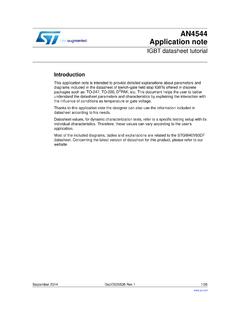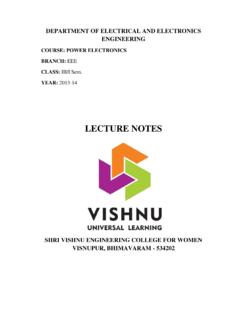Transcription of Drive circuits for Power MOSFETs and IGBTs
1 APPLICATION NOTE1/10AN524/0994 Drive circuits FOR Power MOSFETs AND IGBTsby B. Maurice, L. Wuidart1. INTRODUCTIONU nlike the bipolar transistor , which is current driven, Power MOSFETs , with their insulated gates, arevoltage driven. A basic knowledge of the principlesof driving the gates of these devices will allow thedesigner to speed up or slow down the switchingspeeds according to the requirements of is often helpful to consider the gate as a simplecapacitor when discussing Drive igbt / MOSFET Drive gate vs BasePower MOSFETs and IGBTs are simply voltagedriven switches, because their insulated gatebehaves like a capacitor. Conversely, switches suchas triacs, thyristors and bipolar transistors are current controlled, in the same way as a PN Driving a gateAs shown in figure 2, driving a gate consists ofapplying different voltages: 15V to turn on the devicethrough S1, and 0V to turn off the device through remarkable effect can be seen in both the turn-onand turn-off switching waveforms; the gate voltageexhibits a step , remaining at a constant level whilethe drain voltage rises or falls during switching.
2 Thevoltage at which the gate voltage remains duringswitching is known as the Miller voltage, Vgm. Inmost applications, this voltage is around 4 to 6V,depending on the level of current being feature can be used to control the switchingwaveforms from the gate MOSFET and igbt turn-on / turned on under the same conditions, igbt sand MOSFETs behave in exactly the same way,and have very similar current rise and voltage falltimes - see figure , at turn-off, the waveforms of the switchedcurrent are different, as shown in figure 4. At the endof the switching event, the igbt has a tail current which does not exist for the tail is caused by minority carriers trapped in the base of the bipolar output section of the igbt causing the device to remain turned on.
3 Unlike aFigure 1. Nature of Power semiconductor inputsVgIbAPPLICATION NOTE2/10 Figure 2. Driving MOSFET / igbt gatesFigure 3. MOSFET / igbt turn-onVCCS1S2 RVCCS1S2R3/10 APPLICATION NOTEF igure 4. MOSFET / igbt turn-ofbipolar transistor , it is not possible to extract thesecarriers to speed up switching, as there is no externalconnection to the base section, and so the deviceremains turned on until the carriers recombinenaturally. Hence the gate Drive circuit has no effecton the tail current level and profile. The tail currentdoes however increase significantly igbt turn-off lossesThe turn-off of an igbt can be separated into twodistinct periods, as shown in figure 5. In the firstperiod, its behaviour is similar to that of a increase in drain voltage (dV/dt) is followed by avery fast fall of the switched current.
4 Losses in this dV/dt period depend mainly on the speed of thevoltage increase, which can be controlled by a gatedrive second tail current period is specific to theIGBT. As this period occurs while there is already alarge voltage across the device, it causes losses ateach total turn-off losses are shown in figure 5 by theshaded FROM gate Drive TO Speeding up turn-offThe Power involved in these two types of switchinglosses is linked to the switching frequency. Turn-offlosses become critical when operating at highfrequencies. In this case, the dV/dt can be increased(and hence losses reduced) by decreasing the sizeof the gate Drive resistor Rg, which will allow the gateto charge more quickly. The turn-off losses areproportional to the size of the gate resistor - forexample decreasing the gate resistor from 100 to 10 Figure 5.
5 igbt turn-off lossesRgVDItailIDdVdtTail lossesdV/dt lossesAPPLICATION NOTE4/10will reduce the dV/dt losses by a factor of 10 - seefigure , it should be remembered that igbt tailcurrent losses are completely independent of thevalue of the gate can be noted that in figure 6 the dV/dt and tailcurrent losses are around the same with a gateresistance of 47 .Even though the tail current is constant, the lossesin a system are often predominantly due to dV/dt,because the value of the gate resistance is often toohigh. In the example of figure 7, the total losses percycle are reduced from 13mJ to 4mJ by decreasingthe gate resistance from 100 to 10 . Reducing dV/dt at turn-offConversely, in low frequency applications, fastswitching waveforms can cause problems in theform of EMI.
6 A gate driven switch can be used toreduce the amount of EMI, by slowing down theswitching speed. This is particularly useful inapplications where the mains phase angle dV/dt can be expressed as:dV= Vgmdt(Rg . Ciss)where Vgm (the Miller gate voltage) is around 6V, Crssis the equivalent gate -drain capacitance and Rg isFigure 6. Speeding up turn-offFigure of turn-off losses with gateresistancethe value of the gate resistor at turn-off. One methodof slowing down the switching is thus to slow therate at which the gate capacitor is charged - seefigure 8. This can be achieved using a large gateresistor to make the gate charge more slowly andhence increase the dV/dt time. Throughout the dV/dtperiod, the voltage across the gate resistor is equalto the Miller voltage (Vgm), and for a short time thepower switch operates in linear mode.
7 In thisexample, with a STGP10N50 igbt (Crss 40pF) thedV/dt will be around , a capacitor can be connected betweenthe gate and collector / source of the device, whichincreases the capacitance which must be dischargedthrough the gate resistance at - 1000 VVG= 5V/DIVVD= 200V/DIVID= 5V/DIVt= s/DIVT=60oCdVdt5/10 APPLICATION Reducing dI/dt at turn-off and turn-onA technique which slows both turn-on and turn-offuses a small inductor lE placed in the emitter/sourcelead of the device, as shown in figure 9. The voltagee developed across the inductor during switching,given by:e = be equal to the difference between the gatedrive voltage and the Miller gate voltage (Vgm, around6V). The value of dI/dt can thus be calculated as:dI=(Vg - Vgm)dt lEFor example, in the 4kW example shown in figure 9,at turn-off (Vg = 0V) dI/dt = -6V / 3 H = -2A/ s.
8 Togive an idea, in the circuit used in this example theswitching losses are only around 9. Slowing down the switching of the current using a feedback inductorFigure 8. Slowing down turn-off using a gate resistor470 15 VlE,3 HeVgmdI/dt ONdI/dt OFF= 5A/ s= sAPPLICATION NOTE6/104. THE gate AS A gate as memoryThe capacitive nature of the gate input can beexploited in many different ways, for example as the circuit of figure 10 a single voltage pulseapplied to the gate through diode D1 is sufficient tocharge the input capacitance Cin and turn on theswitch T1. When the pulse has finished, D1 preventsthe gate discharging, and so the device remains on:the gate is behaving as a memory of the on-state ofthe switch. To erase the gate memory and turn offthe switch, a pulse is applied to the diode D2 whichturns on T2, which in turn discharges the gate of T1and turns the device off.
9 As T2 remains on, T1cannot be accidentally turned on due to dV/dt effects,and so the gate of T2 is now behaving as a memoryof the off state of the pulse duration times required to turn thedevices on and off are very small, this principle canbe adapted to suit a wide variety of switchingfrequencies: from almost continuous operation up low frequency applications, refresh pulses can beused to prevent the gate capacitor discharging dueto leakage major benefit of this technique lies in the verysmall size of the pulse transformer required for awide range of switching further information on this subject, seereference Using the gate in resonant circuitsThe gate capacitor can also be used as part of aresonant LC network - see figure 11. With the samepeak current value, the capacitor is charged aroundtwice as fast with an inductor compared to a the resistor is replaced with an inductor, losses inthe gate Drive resulting from the charge and dischargecurrent of the gate capacitor become negligible.
10 Thissolution is particularly efficient in very high frequencyapplications where gate Drive losses become additional benefit is that a resonant circuit has aninherent voltage step-up ability, which means thatthe 15V required to Drive the gate can be generatedfrom a much lower 12 shows an example of the gate capacitancebeing used as part of a resonant type of solution is mainly of use in Drive circuitsof high Power MOSFETs which interface directlywith standard 5V CMOS 10. Using the gate as a state memory7/10 APPLICATION NOTEF igure 11. Using the gate capacitance in a resonant circuitFigure 12. Resonant gate Drive circuitAPPLICATION NOTE8 The gate as an EMI reducerAs mentioned above, the switching waveforms ofPower MOSFETs and IGBTs can easily be slowedby adjusting the value of the gate resistor.











